Tire Size 275/60r20 vs 33×12.50r20
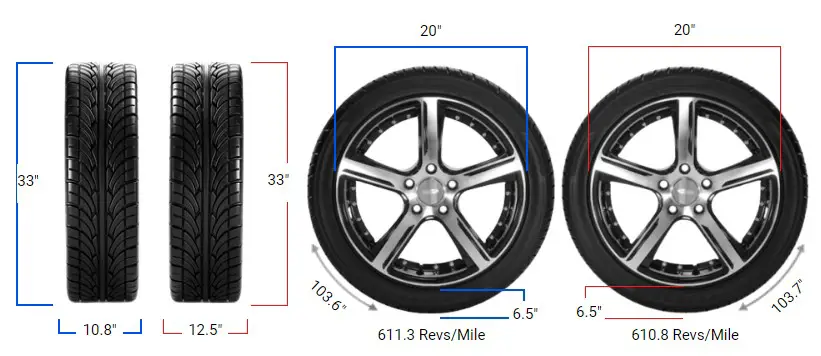
The main difference between 275/60r20 and 33×12.50r20 tires is the section width. The 33×12.50r20 tire size is about 1.69 inch wider than the 275/60r20 tire size.
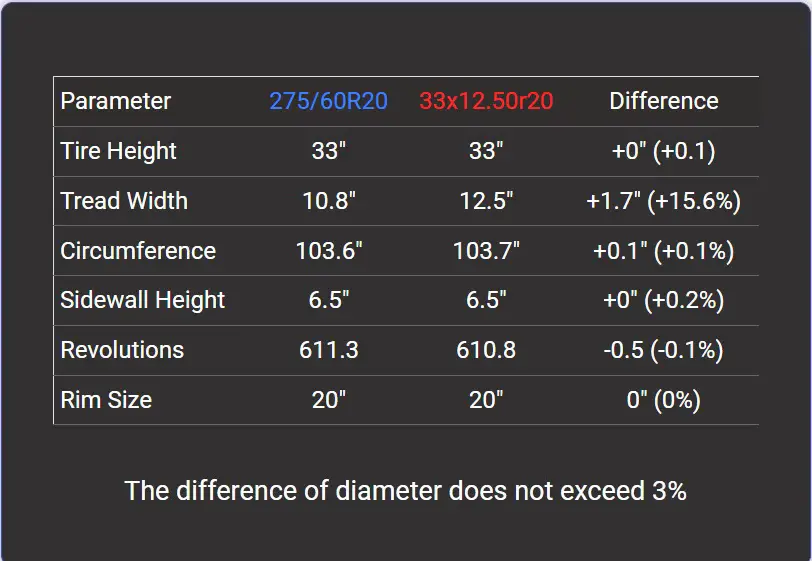
Fitment Guide
When replacing tires, the new set should be within 3% of the overall diameter of the original tires to avoid clearance issues.
The overall diameters of 275/60r20 and 33×12.50r20 tires are very close at 32.99 inches and 33.02 inches, respectively. This 0.1% difference in diameter means both sizes can be installed without modifications.
However, the wider 33×12.50r20 tires may still require trimming or suspension adjustments to prevent rubbing at full steering lock.
Ground Clearance
With almost identical diameters, the ground clearance between 275/60r20 and 33×12.50r20 tires is very similar. The 33×12.50r20 size has 0.01 inches (0.36mm) more clearance due to its fractionally larger diameter.
This minor difference has little effect on obstacle approach angles or off-road capability between the two. Overall, both provide comparable ground clearance.

Gas Mileage
The 33×12.50r20 tires are expected to have slightly worse gas mileage due to increased rolling resistance from their larger contact patch and extra rotational mass from the wider tread and heavier construction.
These factors lead to higher energy consumption, reducing fuel efficiency compared to the narrower 275/60r20 tire. The 275/60r20 is the better choice for gas savings for SUVs and trucks used as daily drivers.
Ride Comfort
With almost identical sidewall heights, the ride comfort difference between 275/60r20 and 33×12.50r20 tires is negligible. Both absorb road imperfections well and prevent harshness from reaching the cabin.
The 33×12.50r20’s slightly larger air volume may provide a subtle improvement in cushioning, but overall, the ride quality is very similar between the two sizes.
Aesthetics
Visually, due to the extra width, the 33×12.50r20 tires will have a bulkier, more aggressive look than the 275/60r20s. This wider stance enhances the vehicle’s style and presence on the road for certain trucks and SUVs.
However, the narrower 275/60r20 retains a balance of aesthetics and performance. Either size can suit different owners’ preferences and sense of style.
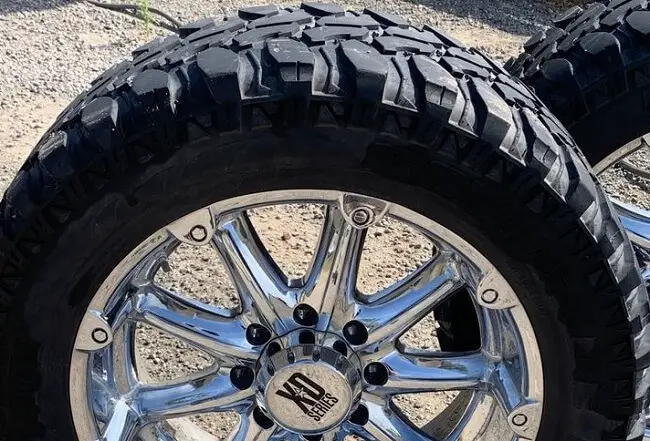
Handling & Stability
The 275/60r20 tire’s reduced width helps sharpen steering response and handling agility due to the more minor contact patch and lighter weight.
In contrast, the wider 33×12.50r20 tire provides more stability control, particularly in slippery conditions where the larger tread blocks can spread grip over more surface area.
Overall traction is similar, but handling leans towards the 275/60r20 while stability favors the 33×12.50r20.
Noise & Vibration
With nearly identical diameters and sidewall heights, noise and vibration differences between these two sizes are minimal. Both absorb irregularities well to isolate the cabin from harshness.
The 33×12.50r20’s marginally more air volume could dampen noise slightly better, but overall noise and vibration levels are comparable.
Durability & Wear
The 33×12.50r20’s heavier construction and added rotating mass may stress wheel bearings and suspension components more than the 275/60r20 during use.
However, the wider 33×12.50r20 tread disperses wear over a larger contact patch, potentially extending tread life. The narrower 275/60r20 is typically the better choice for durability and long-term wear.
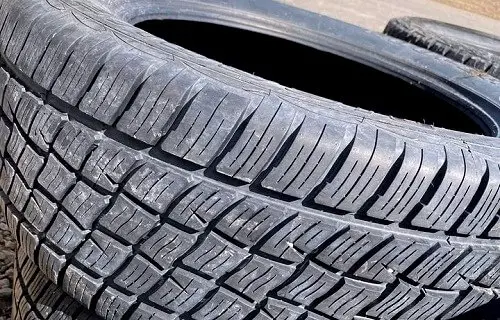
Adverse Conditions
Performance in rain, snow, and off-road conditions is similar between the two. The 33×12.50r20’s stability aids control in slippery conditions.
However, the 275/60r20’s narrower tread and shorter sidewall give it a handling quickness advantage. Overall traction itself is comparable, with neither tire having a significant advantage in adverse conditions.
Speedometer Difference
Due to their nearly identical diameters, the speedometer readings are very close between 275/60r20 and 33×12.50r20 tires.
At an actual speed of 20 mph, the speedometer reads 20.02 mph with the 33×12.50r20 tires and precisely 20 mph with the 275/60r20s. This minor 0.02 mph variance has no practical impact on real-world driving.
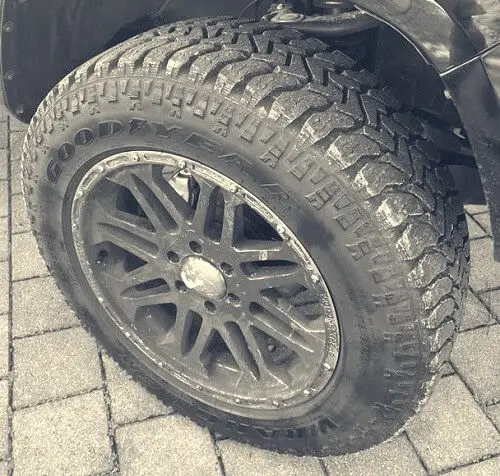
What Does 275/60r20 tire Mean?
The 275 60r20 tire size is a passenger vehicle tire. The “275” refers to the width of the tire in millimeters, the “60” refers to the aspect ratio, and the “20” refers to the rim diameter in inches.
The letter on the tire size means that the tire is a radial tire. A 275 60r20 tire is an excellent all-around size for many vehicles. The tire size 275/60R20 is equivalent to 33×10.8R20 in inches.
Is A 275/60r20 A 33 Inch Tire?
While a 275/60r20 tire is close to a 33-inch tire, it is not exactly the same size. Therefore, while it’s not a perfect match for a 33-inch requirement, the difference is minimal (less than 0.1 inches).
In some cases, this slight discrepancy might be negligible depending on the specific application or tolerance.
How Tall Is A 275/60r20 Tire?
The 275/60R20 tire size has an overall height of approximately 32.99 inches. Keep in mind that actual dimensions can vary slightly between tire manufacturers and models.
What Size Rim For 275/60r20?
The 275/60R20 tire is designed to be mounted on a 20-inch wheel. The rim width range for 275/60r20 tires is 8 inches to 10.00 inches.
How Wide Is 275/60r20?
In the tire size notation “275/60R20,” the first number, 275, represents the width of the tire in millimeters. The width of a 275/60R20 tire is 275 millimeters (mm), or approximately 10.83 inches.
Our Observation
While 275/60r20 and 33×12.50r20 tires share similar diameters, their difference in width results in variances in handling, stability, aesthetics, fuel efficiency, and component wear.
The narrower 275/60r20 offers a better balance for most everyday use, but the wider 33×12.50r20 appeals to certain off-road and style needs.
Understanding these differences allows buyers to select the best tire for their vehicle, driving conditions, and priorities.

Meet Caitlin McCormack, a Tire Size Expert and Blogger Passionate About Everything Related to Tires. With Years of Experience in the Tire Industry, Caitlin Has Become an Expert in Tire Sizes and Their Impact on Vehicle Performance.
